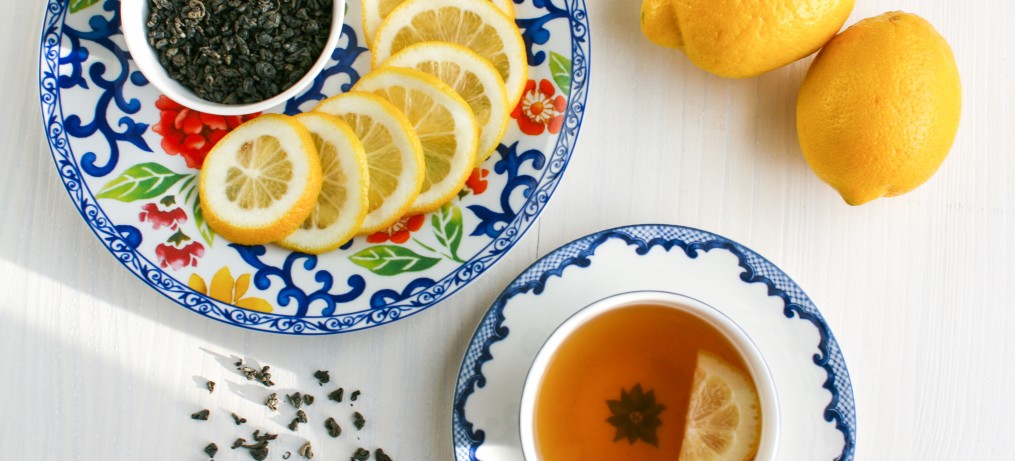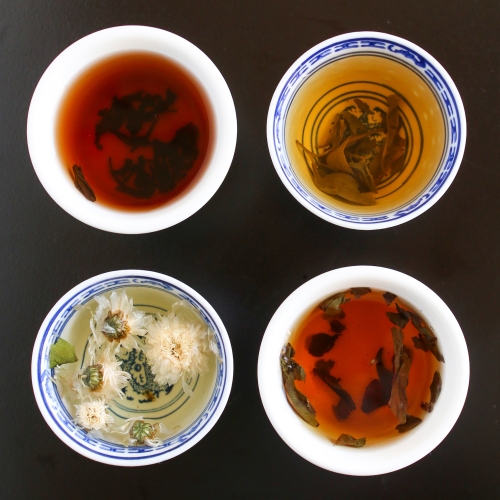 If you’ve ever been seated for a dim sum tea lunch you know that the first thing the waiter will ask you after placing you at your table is “What kind of tea do you want?” In my family, we always respond with “bo-lay'” and in my husband’s family they always respond with “gook-fa.” The two teas are as opposite as they come, but both unique and tasty in their own special way.
If you’ve ever been seated for a dim sum tea lunch you know that the first thing the waiter will ask you after placing you at your table is “What kind of tea do you want?” In my family, we always respond with “bo-lay'” and in my husband’s family they always respond with “gook-fa.” The two teas are as opposite as they come, but both unique and tasty in their own special way.
When you order tea with your waiter at a dim sum restaurant, it’s not like you can order any Chinese tea you want. Each restaurant has a basic set of teas that suit a wide variety pallets, and these 4 types are among the most popular.
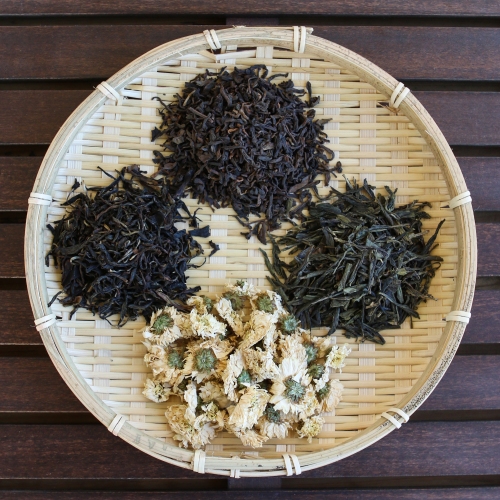
Clockwise from top: Pu-Erh, Dragonwell, Chrysanthemum, and Oolong
In a multi-ethnic place like LA, even the non-Chinese waiters at our favorite dim sum places know the names of the teas they offer in English, Cantonese, and Mandarin…how impressive is that? Surely if those waiters can remember all the names, patrons should be able to make it clear which tea they want.
My suggestion? Just spew out the Cantonese name of your tea choice. As I’ve mentioned in my other dim sum posts, bashfulness isn’t rewarded at dim sum restaurants so go for it! After all, the faster you make up your mind at a Chinese restaurant the sooner the food will arrive, so here’s a list of a few of my favorite teas that your local dim sum restaurant will very likely offer. Get the pronunciations right and you’ll soon be sipping your way through a delicious meal!
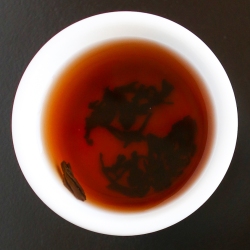
Pu-Erh, a Black Tea (Bo-Lay in Cantonese)
Chinese dumplings and tea treats are commonly laden with a fair amount of lard. It’s just a fact. People are always surprised when I tell them this though…it’s as if I just came by and burst their happy dim sum bubble. I’m glad to offer some lard-free recipes on my blog, but rest assure the dim sum establishments will be sticking to traditional ingredients.
This being the case, Pu-Erh’s earthy, deep taste is fantastic for pairing with higher fat or pan-fried foods. Drunk steamy hot, it cuts though grease like no other. This is a black tea that takes on a slight mustiness in the process of fermentation. Many refer to it as the wine of teas, meaning that it ripens with age and that older is considered better.
By many peoples’ standards, Pu-Erh is an acquired taste so drink it with an open mind, knowing that it isn’t going to taste like your morning cup of Earl Grey. If you’ve ever tasted Pu-Erh before and didn’t like it, you should really give it another shot while eating a dim sum meal. And if you still don’t like it then it might just be time to try another tea with your dim sum…read on!
To brew Pu-Erh at home, add 1 tsp of packed/brick Pu-Erh or 1 Tbsp of loose-leaf Pu-Erh to your teapot, pour boiling (212 degrees F) water atop leaves, then steep for 3-5 minutes before removing the leaves.
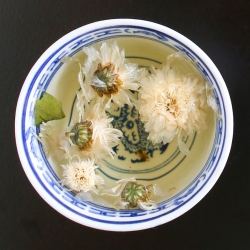 Chrysanthemum, an Herbal Tea (Gook-Fa in Cantonese)
Chrysanthemum, an Herbal Tea (Gook-Fa in Cantonese)
Gook-Fa is a really great option for those who are going caffeine-free. Where Pu-Erh is dark and earthy, chrysanthemum is light and sweet. This herbal is composed completely of flower blossoms, and has a mild taste and light yellow color, much like a chamomile tea.
You’ll notice that Gook-Fa goes particularly well with dim sum specialties like steamed dumplings, seafood-based bites, and light desserts where the tea’s gentle fragrance carries through without being overwhelmed. You can find sweetened chrysanthemum tea packaged into cartons at Asian markets, but it is never served with sugar at dim sum restaurants, so please don’t expect any sugar packets! Flowery chrysanthemum tea is an exceptionally good choice for the caffeine-sensitive, for kids, and for non-tea drinkers.
To brew Chrysanthemum at home, rinse about 20 flower buds under water to remove any debris, then add them to your teapot. Pour boiling (212 degrees F) water atop buds, then steep for at least 5-7 minutes. Since this is a milder tea, let the buds continue to steep for as long as you want…the brew should never get to a point where it’s too strong. If you prefer, remove the steeped buds, then add sugar or honey to taste and serve chilled!
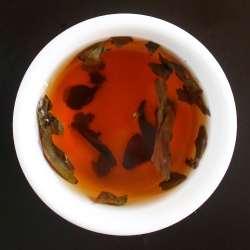 Oolong, a “Blue” Tea (Wu-Long in Cantonese)
Oolong, a “Blue” Tea (Wu-Long in Cantonese)
Oolong is the well-rounded tea choice for dim sum. Both in taste and in the way it’s prepared, oolong lies somewhere between black and green tea, which is why it’s sometimes called “blue.” Oolongs ferment just like black teas do, but for a shorter amount of time. This shortened fermentation process means that the resulting liquor has both depth and brightness at the same time.
Being what I call a “middle of the road” tea, generally everyone loves Oolong. This brilliant coppery tea complements most everything on the dim sum menu. It’s able to tame saltier and spicier meat dishes while boosting the flavor of stuffed buns and other baked dim sum treats. When all else fails, ask for Oolong!
To brew Oolong at home, add 1 tsp of rolled Oolong or 1 Tbsp of long-leaf Oolong to your teapot, then pour almost boiling (180-205 degrees F) water atop leaves. Steep for 4-5 minutes before removing the leaves. If you’ve already let the water come to a full boil, wait a about 5 minutes before adding it to the leaves.
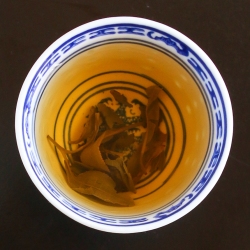
Dragonwell, a Green Tea (Lung-Jeng in Cantonese)
Dragonwell, also spelled Lung Ching or Lung Jiang, is a grassy, fresh, vegetal tea. Some say that the tea tastes of steamed baby bok choy, which makes sense since Dragonwell tea leaves are pan-fired shortly after picking to stop the oxidation (blackening) process. This accounts for the green coloring of its leaves.
I describe Lung Jeng as “clean” tasting. As such, this green tea makes a fantastic palette cleanser in between bites, giving each unique dim sum food choice its own fair chance to shine.
Like Pu-Erh, Dragonwell can cut through greasiness in food. Consider Lung Jeng the best choice for people who don’t enjoy Pu-Erh’s characteristic earthiness but still want an invigorating tea to quell that unpleasant feeling when you’ve had one-to-many deep-fried egg rolls!
To brew Dragonwell at home, add 1 heaping tsp of Dragonwell to your teapot, pour hot (185 degrees F) water atop leaves, then steep for 3 minutes before removing the leaves. When water is heating, 185 degrees F is around the time when you see the first wisp of steam escape from the spout on the kettle.
 Before spring sneaks away from us I want to introduce you to Steven Smith Teamaker’s Spring Harvest. This blend is made from Mao Feng, a green tea that grows in Zhejiang, China. As much as I love Japanese green teas for their clean and grassy taste, I think that Chinese green teas tend to have much more depth and complexity in flavor. This could mean differences in how the tea is grown, how the tea leaf is picked, or how the tea is processed after picking. In general, the process for creating Japanese green teas is considered more mechanized than the making of Chinese green teas.
Before spring sneaks away from us I want to introduce you to Steven Smith Teamaker’s Spring Harvest. This blend is made from Mao Feng, a green tea that grows in Zhejiang, China. As much as I love Japanese green teas for their clean and grassy taste, I think that Chinese green teas tend to have much more depth and complexity in flavor. This could mean differences in how the tea is grown, how the tea leaf is picked, or how the tea is processed after picking. In general, the process for creating Japanese green teas is considered more mechanized than the making of Chinese green teas. The best word I can use to describe the flavor of Smith’s Spring Harvest is bright. The brightness of this steep is the result of it having been grown at a high elevation. It is thought that teas grown at higher altitudes also grow slower, and thus have more time to develop complex flavor profiles. Even better yet, these high altitude teas are richer in antioxidants!
The best word I can use to describe the flavor of Smith’s Spring Harvest is bright. The brightness of this steep is the result of it having been grown at a high elevation. It is thought that teas grown at higher altitudes also grow slower, and thus have more time to develop complex flavor profiles. Even better yet, these high altitude teas are richer in antioxidants!